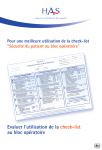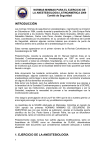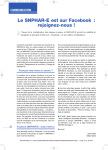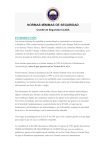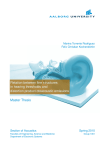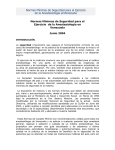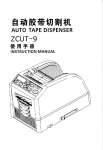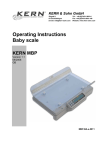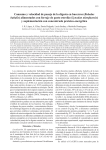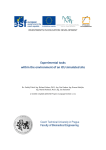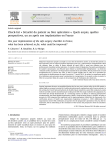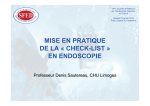Download normas mínimas 2009 para el ejercicio de la
Transcript
Normas mínimas 2009 para el ejercicio de la anestesiología en Colombia Minimum standards 2009 for practising anaesthesiology in Colombia 235 Rev. Col. Anest. agosto-octubre 2009. Vol. 37- No. 3: 235-253 Investigación científica y tecnológica Normas mínimas 2009 para el ejercicio de la anestesiología en Colombia Comité de Seguridad Minimum standards 2009 for practising anaesthesiology in Colombia Safety Committee Pedro Ibarra MD*, Bernardo Robledo MD**, Manuel Galindo MD***, Claudia Niño MD****, David Rincón MD***** Recibido: noviembre 06/2009 - Aceptado: noviembre 11/2009 Resumen Summary Esta es una actualización de las Normas Mínimas del 2003. Sus cambios principales son la inclusión de la Lista de Chequeo, propuestas de formatos de evaluación preanestésica, registro intraoperatorio, registro de UCPA, y consentimiento informado. Además se agregan ítems que extienden el rol del anestesiólogo como participación en la tromboprofilaxis, profilaxis antibiótica, y definición explicita del manejo del dolor perioperatorio que son pilares de la medicina perioperatoria. Se incluye también la necesidad de generar bases de datos para registrar información perioperatoria y sugerencias para la disponibilidad y uso de medicamentos seguro. Por último se actualizan los laboratorios preanestésicos recomendados. This updates Minimum Standards 2003. The main changes concern including the Check List; proposals for preanaesthetic evaluation forms; intraoperative records; UCPA record; and informed consent. Items have also been added extending the anaesthesiologist’s role by participating in thromboprophylaxis, antibiotic prophylaxis and an explicit definition for managing perioperative pain as the main support for perioperative medicine. The need for generating databases for recording perioperative information and suggestions for the availability and use of safe medicaments are also included. The list of recommended preanaesthetic laboratories has also been updated. Palabras clave: administración de la seguridad, atención perioperatoria, evaluación de procesosy resultados, guía como adjunto (fuente: Decs, Bireme). Key words: standarization, safety management, monitoring interaoperative, preoperative cared, standards, outcome assessment, guideline as topic (source: MeSH, NLM). * Anestesiólogo Trauma Anestesia & Cuidado Crítico Clinicas Colsanitas; Comite Educación WFSA, Comité Seguridad SCARE/CLASA, Coordinador Postgrado Anestesia Unisanitas. Email: [email protected] ** Anestesiólogo Clínica del Country *** Anestesiólogo, Profesor Universidad San Martín **** Neuroanestesiólogo Fundación Santa Fe de Bogotá; Profesor UniAndes ***** Anestesiólogo; Instructor Universidad Nacional; Delegado Hipertermia Maligna SCARE 236 Rev. Col. Anest. agosto-octubre 2009. Vol. 37- No. 3: 235-253 Objetivos: Estas normas mínimas tienen como finalidad ulterior mejorar la seguridad del ejercicio profesional de la anestesiología en Colombia, a través de la recomendación de estrategias que tienen soporte para su implementación. Objectives: The purpose of these minimum standards is to improve safety when practising anaesthesiology in Colombia by recommending strategies having support for their implementation. Metodología: En las normas previas se ha indicado la necesidad de revisarlas periódicamente, según aparezcan nuevas aproximaciones con demostrado beneficio en la seguridad de los pacientes, que se someten a intervenciones anestésicas. El motor principal para actualizarlas surge por la aparición de la campaña mundial “Cirugía Segura, Salva Vidas” de la Organización Mundial de la Salud en agosto 2008. A partir de esta, el Comité de Seguridad decide incluir estas recomendaciones y actualizar otros aspectos. Methodology: Previous standards have indicated the intrinsic need for them to be periodically revised as new approaches appear having demonstrated benefit regarding the safety of patients who undergo anaesthetic interventions. The main impulse for updating them has emerged from the appearance of the World Health Organisation’s worldwide campaign entitled, “Safe Surgery, Saves Lives” launched in August 2008. The Safety Committee thus decided to include these recommendations and update other aspects. Usando la técnica Delphi(1,2) se hicieron seis iteraciones electrónicas que se resumieron con reuniones virtuales hasta producir el documento final que fue presentado y aprobado en el Congreso Colombiano de Anestesiología en marzo del 2009. The Delphi technique(1,2) was used for making six electronic iterations which were summarised in virtual meetings until the final document was produced; this was presented to and approved by the Colombian Anaesthesiology Congress in March 2009. Las Normas Mínimas colombianas pretenden inducir cambios en la práctica nacional para mejorar los estándares de seguridad.(3-5) The Colombian Minimum Standards attempt to induce changes in national practice for improving safety standards.(3-5) INTRODUCCIÓN Las normas mínimas de seguridad en anestesiología y reanimación se iniciaron en Colombia en 1984, cuando durante la presidencia del Dr. Julio Enrique Peña se encomendó a los doctores Tiberio Álvarez(6), Mario Granados(7), Alfredo León(8), Sebastián Merlano(9), Carlos Julio Parra(10), Arnobio Vanegas(11) y Manuel Galindo(12), coordinados por el presidente, en su condición de miembros del Comité de Seguridad, elaborar algunas normas básicas que sirvieran de punto de referencia dentro de la práctica de la anestesiología en el país. Estas normas aparecieron en el primer número de la Revista Colombiana de Anestesiología de 1985. Posteriormente, durante la presidencia del Dr. Manuel Galindo en la Sociedad Cundinamarquesa de Anestesiología en 1987 se envió una comunicación a todas las entidades hospitala- Introduction Minimum safety standards in anaesthesiology and reanimation were first introduced in Colombia in 1984 when doctors Tiberio Álvarez, Mario Granados, Alfredo León, Sebastián Merlano, Carlos Julio Parra, Arnobio Vanegas and Manuel Galindo Arias (members of the then Safety Committee) were entrusted with drawing up some basic standards which would serve as a reference point for practising anaesthesiology in Colombia during the presidency of Dr. Julio Enrique Peña (who would coordinate their efforts). These standards appeared in the first issue of the Revista Colombiana de Anaesthesiology in 1985. Later on, during Dr. Manuel Galindo Arias’ presidency of the Sociedad Cundinamarquesa de Anestesiologia in 1987, a communication was sent to all hospital entities notifying both anaesthesiologists and hospital managers of the mi- Normas mínimas 2009 para el ejercicio de la anestesiología en Colombia Minimum standards 2009 for practising anaesthesiology in Colombia 237 rias, en la cual se les notificaba, tanto a anestesiólogos como a directivos hospitalarios, los mínimos elementos de monitoría que a juicio de la Sociedad debería tener todo paciente que fuese llevado a cirugía Este documento fue bastante controvertido, incluso dentro de los mismos anestesiólogos: algunos sostenían que, basados en dicha comunicación, un anestesiólogo podría llegar a tener problemas legales por suministrar anestesia sin alguno de los elementos enunciados Este temor era fundado, pero fue satisfactorio poder comprobar que gracias a la tenacidad de la Sociedad Cundinamarquesa y posteriormente de la SCARE, se logró que las instituciones, presionadas por los anestesiólogos y por la Sociedad, aceptaran la necesidad de proveer a los anestesiólogos con la monitorización adecuada Vino luego la promulgación de la Ley 6ª de 1991 que le dio a nuestro gremio un arma legal para exigir lo que sin Ley ya estábamos exigiendo La Asamblea de la SCARE efectuada en Manizales en Agosto de 1991 aprobó las primeras Normas Mínimas de Seguridad en Anestesia que con ese nombre se publicaron, gracias al invaluable aporte científico de los Drs. Pedro Ibarra y Germán Parra, las que se difundieron ampliamente, tanto en Colombia como en Latinoamérica.(3-5,13) Posteriormente estas normas han sufrido algunas modificaciones, tanto en Asambleas de SCARE como en Asambleas de CLASA, obteniéndose finalmente este documento que consideramos bastante adecuado a nuestra situación EJERCICIO DE LA ANESTESIOLOGÍA Evaluación preanestésica Es mandatoria en todo paciente. En ella el médico anestesiólogo debe establecer el estado clínico del paciente, su estado físico según la clasificación del estado físico de la American Society of Anesthesiologists (ASA) y las pautas de manejo que considere pertinentes. Debe consignarse explícitamente todo lo referido a continuación. (Puede servir de patrón el anexo 1) nimum monitoring elements which should be taken into account (in the Society’s opinion) when any patient might have to undergo surgery. This document was extremely controversial, even amongst anaesthesiologists; some of them maintained that, based on such communication, an anaesthesiologist could become involved in legal problems due to supplying anaesthesia if they lacked any of the stated elements in so doing. Such fear was well-founded, but was satisfactorily resolved due to the Cundinamarca society’s tenacity and later that of SCARE, meaning that institutions being pressured by anaesthesiologists and the society accepted the need for providing anaesthesiologists with suitable monitoring. Law 6ª/1991 provided our profession with a legal weapon for demanding that which we had already been demanding without the backing of law. SCARE’s assembly (held in Manizales in August 1991) approved the first Minimum Safety Standards in Anaesthesia (published under this title) due to Dr Pedro Ibarra and Dr Germán Parra’s invaluable scientific support; they were widely distributed throughout Colombia and Latin-America These standards have undergone some modifications in both SCARE’s assemblies and those of CLASA, finally leading to this document which we consider extremely suitable for our situation. Practising anaesthesiology Pre-anaesthetic evaluation This is mandatory for all patients. During this, an anaesthesiologist must establish a patient’s clinical and physical state according to the American Society of Anesthesiologists’ (ASA) classification of pertinent physical and management guidelines. All that set out below must be explicitly adhered to (Appendix 1 could serve as a pattern). 238 Rev. Col. Anest. agosto-octubre 2009. Vol. 37- No. 3: 235-253 Consulta Preanestésica Pre-anaesthetic consultation - Debe incluir antecedentes, estado clínico, revisión de exámenes paraclínicos (ver sección 9), conceptos de otros especialistas, ASA. Si se considera necesario, se pedirán nuevos exámenes o conceptos especializados - This must include background, clinical state, a review of paraclinical exams (see section 9), concepts from other specialists, ASA. New exams may be ordered or specialised opinion sought if considered necessary. - El día de la cirugía, el especialista a cargo del caso debe revisar que la información anterior esté completa y consignada en el registro anestésico - On the day of surgery, the specialist in charge of the case must ensure that the above information is complete and has been documented on the anaesthetic record. - Se debe informar al paciente o a sus familiares sobre el riesgo del acto anestésico y se debe obtener el consentimiento informado - The patient or family members must be informed about the risk of anaesthetic being applied and the informed consent form must have been signed. Consulta Preanestésica Intrahospitalaria Intrahospital pre-anaesthetic consultation Es la que se realiza en los pacientes hospitalizados. En ella debe establecerse el estado clínico actual. Se debe informar al paciente, si no se ha hecho previamente, sobre el riesgo del acto anestésico y se debe obtener el consentimiento informado This applies to hospitalised patients; the current clinical state must be established during this consultation. The patient must be informed (if this has not already been done) about the risk of anaesthetic being applied and informed consent must have been obtained. Evaluación en Urgencias Evaluation in the emergency room El paciente de urgencia debe ser sometido a la evaluación preanestésica (inmediata) que su condición y las circunstancias permitan A patient in an emergency room must be given (immediate) pre-anaesthetic evaluation in so far as his/her condition and circumstances allow. Preparacion perianestésica Lista de Chequeo (14,15) El anestesiólogo debe colaborar con el cirujano y el resto del equipo quirúrgico para completar una lista de chequeo global del paciente con al menos los ítems de la lista de chequeo recomendada y validada por la OMS/OPS y que ha sido adoptada por la SCARE (ver anexo 2) Antes de iniciar el acto anestésico, el anestesiólogo debe hacer una revisión que incluya lo siguiente: - Máquina de anestesia - Adecuada presión de oxígeno y de otros gases a utilizar - Presencia de bala de oxígeno de emergencia - Buen funcionamiento del dispositivo para administración de oxígeno de flujo rápido (flush) Peri-anaesthetic preparation Check list An anaesthesiologist must collaborate with the surgeon and the rest of the surgical team in completing an overall check list for a particular patient containing at least the items from the check list recommended and validated by WHO/ PAHO and which has been adopted by SCARE (see Appendix 2). Before beginning to apply anaesthetic, an anaesthesiologist must review the following: - The anaesthesia machine; - Adequate oxygen pressure and for other gases to be used; - An available emergency oxygen supply (with shutoff ball valve); Normas mínimas 2009 para el ejercicio de la anestesiología en Colombia Minimum standards 2009 for practising anaesthesiology in Colombia 239 - - Good functioning of the device for administering oxygen rapidly (flush); - Good state of flowmeters, vaporisers, circuits (without leaks), unidirectional valves, pressure relief valve and CO2 absorber; and Monitoreo - Good ventilator functioning. - Monitoring - Buen estado de flujómetros, vaporizadores, circuitos (sin fugas), válvulas unidireccionales, válvula de sobrepresión y absorbedor de CO2 Buen funcionamiento del ventilador Básico: fonendoscopio, monitoreo electrocardiográfico, tensiómetro, oxímetro, capnógrafo y termómetro cutáneo/esofágico o timpánico - Paciente - Verificar y anotar si hay cambios respecto a la evaluación preanestésica Basic: phonendoscope, electrocardiographic monitoring, tensiometer, oximeter, capnograph and cutaneous/esophageal or tympanic thermometer. The patient - Verify and note whether there have been any changes regarding the pre-anaesthetic evaluation; - Los exámenes paraclínicos requeridos - Consentimiento informado (propuesta Anexo 3) - Cavidad oral: dificultad para la intubación o prótesis Have the required paraclinical exams been made; - Has informed consent been obtained (proposal in Appendix 3); - Oral cavity: difficulty for intubation or prosthesis; and - Venous route - - Vía venosa Posición del paciente - - Se deben conocer las necesidades de posicionamiento del paciente durante el procedimiento Deben disponerse de los elementos para proteger al paciente en los puntos de presión y en las posiciones no anatómicas The patient’s position - Needs regarding positioning the patient during the procedure must be known; and - Elements must be available for protecting the patient at pressure points and in nonanatomic positions. Materiales, Medicamentos y Equipo (ver anexo 4 lista mínima) - Equipo básico para el manejo de la vía aérea Materials, medicaments and equipment (see Appendix 4: minimum list) - Medicamentos a utilizar - - Succión Basic equipment for managing the aerial route; - En el área quirúrgica debe haber disponible un desfibrilador y un equipo para manejo de vía aérea difícil. (Ver 1.3.11) - The medicaments to be used; - Suction; and - A defibrillator and equipment for managing difficult aerial routes must be available in the surgical area (see 1.3.11). Hipertermia maligna (16) - Es altamente deseable que todo sitio con ofrecimiento de servicios anestesiológicos tenga estrategias explícitas para la obtención urgente de dantrolene para el manejo de una crisis de hipertermia maligna Malign hyperthermia - It is highly desirable that all sites offering anaesthesiological services have explicit 240 Rev. Col. Anest. agosto-octubre 2009. Vol. 37- No. 3: 235-253 Registro Anestésico: Debe incluir: (puede usarse el propuesto en el Anexo 5) strategies for urgently obtaining dantrolene for managing a malign hyperthermia crisis. - Aspectos clínicos relevantes para el procedimiento anestésico The anaesthetic record must include (that proposed in Appendix 5 may be followed): - Monitoreo del paciente - - Drogas administradas The relevant clinical aspects for the anaesthetic procedure; - Líquidos administrados - Monitoring a patient; - Técnica empleada - The drugs to be administered; - Estado del paciente al final del acto anestésico - The liquids to be administered; - The technique used; - Monitoreo Básico Intraoperatorio - - Estrategias para el control del dolor postoperatorio The patient’s state at the end of anaesthetic having been applied; - Basic intraoperative monitoring; and - Strategies for controlling postoperative pain Siempre debe haber un médico anestesiólogo responsable del acto anestésico durante todo momento en la sala de cirugía. En el quirófano debe haber personal entrenado para colaborar en el monitoreo y en la ejecución del acto anestésico Todo procedimiento anestesiológico invasivo deberá realizarse previo lavado de manos 17 Cuidado perianestésico Durante el acto anestésico se debe evaluar permanentemente la oxigenación, la ventilación y la circulación del paciente A qualified anaesthesiologist must always be present in the operating room who is solely responsible for the anaesthetic being applied at all times. Personnel must be present in the operating room who have been trained in collaborating in monitoring and apply anaesthetics; and All invasive anaesthesiological procedures must be done only after washing the hands. Peri-anaesthetic care Oxigenación: Patient oxygenation, ventilation and circulation must be constantly evaluated whilst the anaesthetic is being applied. - Oxygenation: - Debe medirse la saturación del oxígeno en sangre mediante un oxímetro de pulso Debe medirse la concentración de oxígeno en el gas inspirado mediante un analizador de oxígeno - The blood’s oxygen saturation must be measured by using a pulse oximeter; and - Oxygen concentration in inspired gas must be measured by an oxygen analyser. Ventilación Ventilation - Cuando se utilicen métodos para controlar la vía aérea, se deben auscultar los ruidos respiratorios, evaluar la excursión del tórax, y observar el balón reservorio - - Cuando se practique intubación endotraqueal, se debe verificar la posición del tubo a través de la auscultación When methods are used for controlling the aerial route, respiratory noises must be auscultated, evaluating the excursion of the thorax and observing the oxygen reservoir ball; - The tube’s position must be verified by auscultation when endotracheal intubation is practised; Normas mínimas 2009 para el ejercicio de la anestesiología en Colombia Minimum standards 2009 for practising anaesthesiology in Colombia 241 - Si la ventilación es mecánica, se debe contar con alarmas que indiquen fallas en el circuito o su desconexión - If ventilation is mechanical, then alarms indicating faults in the circuit or when it becomes disconnected must be available; - Si hay intubación endotraqueal o algún otro dispositivo que controle la vía aérea (máscara laríngea o cánula orofaríngea COPA -cuffed oropharyngeal airway- o afín), se deberá tener alarma de presión alta de la vía aérea - - La capnografía es un elemento de monitoreo básico en todo paciente sometido a anestesia general If there is endotracheal intubation or another device controlling the aerial route (laryngeal mask or cuffed oropharyngeal airway - COPA - or similar) then there must have an alarm for high aerial route pressure; - Capnography is a basic monitoring element in all patients being given general anaesthesia; - Ventilation must be constantly evaluated by clinical signs during regional anaesthesia; - If the anaesthesia machine is provided with a ventilator, this must have the following minimum parameters: - Durante anestesia regional se debe evaluar permanentemente la ventilación mediante signos clínicos - Si la máquina de anestesia está provista de ventilador, éste debe tener los siguientes parámetros mínimos: • Respiratory frequency control; • Control de frecuencia respiratoria • Control for fixing current volume and minute volume; • Control para fijar volumen corriente y volumen minuto • Control for inspiration/expiration ratio; • Control para relación inspiración/espiración • Alarms for maximum inspiratory pressure and disconnection; and • Alarmas para presión inspiratoria máxima y de desconexión • An aerial route pressure monitor should ideally be placed on the ventilator, thereby enabling expired current volume to be measured. • Al ventilador se le debe poder monitorizar la presión de la vía aérea, siendo deseable la posibilidad de medir volumen corriente espirado Circulation - A patient must have constant electrocardiographic monitoring; - Blood pressure and cardiac frequency must be taken at least every five minutes; and - When considered necessary, an anaesthesiologist must turn to palpating the pulse or auscultation of cardiac noises. Circulación - El paciente debe tener monitoreo electrocardiográfico permanentemente - Se deben hacer tomas de tensión arterial y frecuencia cardiaca por lo menos cada cinco minutos - Cuando lo considere necesario, el anestesiólogo recurrirá a la palpación del pulso o a la auscultación de los ruidos cardiacos Temperatura - Es mandatoria en cirugía cardiaca, en trauma moderado o severo, en cirugía de neonatos y de infantes menores, en cirugías de más de tres horas y en aquellas en la que Temperature - Monitoring temperature is mandatory in cardiac surgery, in moderate or severe trauma, in neonatal surgery and for minors/ infants, in surgery lasting more than three hours and in surgery where blood loss greater than volume of blood is foreseeable. There must always be the possibility for monitoring temperature; and 242 Rev. Col. Anest. agosto-octubre 2009. Vol. 37- No. 3: 235-253 - se prevean pérdidas sanguíneas superiores a la volemia. Siempre debe haber la posibilidad de monitorizar la temperatura. It is highly desirable that methods are available for avoiding a patient cooling down and/or heating up. Es altamente deseable disponer de métodos para evitar el enfriamiento, y/o calentar al paciente. Central nervous system Sistema Nervioso Central Es recomendable el uso de análisis biespectral o similares, en pacientes bajo anestesia total intravenosa o con técnicas basadas en opioides Gases anestésicos: El monitoreo de los gases anestésicos inspirados y espirados es altamente deseable Using bispectral analysis or similar is recommendable in patients being given low total intravenous anaesthesia or when opioid-based techniques are being used. Anaesthetic gases: Monitoring inspired and expired anaesthetic gases is highly desirable. Other elements involved in monitoring: - Diuresis, invasive arterial pressure, venous oxygen saturation, cardiac output, central venous pressure, pulmonary artery pressure must be monitored as well as other parameters according to need when a patient’s condition or the type of surgery require it; and - It is highly desirable that muscular relaxation be monitored by peripheral nerve stimulator. Otros elementos de monitoreo: - - Cuando las condiciones del paciente o el tipo de cirugía lo requieran, se deberá monitorizar la diuresis, la presión arterial invasiva, la saturación venosa de oxígeno, el gasto cardiaco, presión venosa central, la presión de arteria pulmonar, y otros parámetros según necesidad Es altamente deseable monitorizar la relajación muscular mediante el estimulador de nervio periférico Nota 1: alarmas y monitores: Durante todo el tiempo que dure el procedimiento anestésico, los monitores deben permanecer prendidos, con las alarmas activadas y con el volumen adecuado para que puedan ser escuchadas. Se considera práctica muy peligrosa desconectar o silenciar las alarmas sin una justificación expresa, tanto en el quirófano como en la UCPA, mientras el paciente esté bajo el cuidado de un anestesiólogo NOTA 2: Disponibilidad para RCCP En el área en la cual se administre anestesia debe disponerse siempre de todos los elementos necesarios para practicar reanimación cerebrocardio-pulmonar (RCCP), incluyendo las drogas pertinentes y el desfibrilador, cuyo funcionamiento debe verificarse periódicamente. El anestesiólogo es por definición experto en RCCP Note 1: alarms and monitors: Monitors must always be switched on during the whole time the anaesthetic procedure lasts; the pertinent alarms must be activated and have suitable volume so that they may be heard. It is considered a very dangerous practice to disconnect or silence alarms without express justification in both the operating room and postanaesthetic care unit (PACU) whilst a patient is being cared for by an anaesthesiologist. Note 2: CCPR availability All the necessary elements for practising cerebral-cardio-pulmonary reanimation (CCPR) must always be available in the area where anaesthesia is administered, including the pertinent drugs and defibrillator whose good functioning must be verified periodically. An anaesthesiologist is, by definition, an expert in CCPR. Normas mínimas 2009 para el ejercicio de la anestesiología en Colombia Minimum standards 2009 for practising anaesthesiology in Colombia 243 Equipo mínimo para el manejo de la vía aérea Toda institución hospitalaria que cuente con servicios de anestesiología, debe tener disponible las 24 horas un Carro de Vía Aérea, móvil, con los siguientes elementos: Minimum equipment for managing the aerial route All hospitals having an anaesthesiology service must have a mobile aerial route cart available 24 hours a day having the following elements: - Hojas de laringoscopio curvas y rectas de diferentes tamaños, incluidas pediátricas - Different sized curved and straight laryngoscope blades, including paediatric ones; - Bujías o guías - Plugs or guides; - Máscaras laríngeas de diferentes tamaños, incluidas pediátricas - Different sized laryngeal masks, including paediatric ones; - Equipo para practicar cricotiroidotomía por punción o percutánea - - Es altamente recomendable disponer de una máscara laríngea tipo Fastrach® Equipment for practising cricothyroidotomy by puncture or percutaneous transtracheal ventilation; - - Además, en hospitales de tercero y cuarto nivel debe contarse con un fibrobroncoscopio It is highly recommended to have a Fastrach laryngeal mask available; - A fibrobroncoscope should also be available in third and fourth level hospitals; and - En estos hospitales de tercer o cuarto nivel, también es deseable disponer de elementos para practicar intubación retrógrada - Such third or fourth level hospitals should also have available elements for practising retrograde intubation. Entrega de pacientes - Cuando un anestesiólogo tiene que entregar su paciente a otro anestesiólogo, debe informarle la condición previa del paciente, el manejo realizado, eventos relevantes y plan inmediato - En el registro anestésico el anestesiólogo que entrega debe dejar constancia de la entrega y de las condiciones del paciente en ese momento Handing over patients - When an anaesthesiologist has to hand a patient over to another anaesthesiologist then the patient’s previous condition must be reported to the to the anaesthesiologist taking over, as must all management undertaken up to this point, relevant events and the immediate plan; and - The anaesthesiologist handing over the anaesthetic record must ensure that it states that it has been handed over and that a particular patient’s condition has been fully noted at this precise moment. Normas específicas para la anestesia obstétrica (adicional a las normas mínimas generales) - - - Ningún procedimiento anestésico debe practicarse hasta que la paciente y el feto hayan sido evaluados por la persona acreditada para ello En la sala de cirugía debe haber una persona calificada, diferente del anestesiólogo, para atender al recién nacido Ante la ausencia del pediatra, la responsabilidad del anestesiólogo es primero para con la madre; si ésta no corre ningún peligro, el anestesiólogo podrá asistir al recién nacido Specific standards for obstetric anaesthesia (additional to general minimum standards) - No anaesthetic procedure must be practised until the patient and foetus have been evaluated by a person accredited to do so; - A qualified person (different to the anaesthesiologist) must be present in the operating room for attending the new-born; - In the absence of a paediatrician, the anaesthesiologist’s first concern is for the 244 Rev. Col. Anest. agosto-octubre 2009. Vol. 37- No. 3: 235-253 - Después de un procedimiento diferente a la analgesia obstétrica con peridural, todas las pacientes deben ir a una unidad de cuidado postanestésico UCPA mother; if she runs no risk then the anaesthesiologist may attend the new-born; and - Cuidado postanestésico (18) - - - - - En toda institución hospitalaria debe existir un sitio en donde se haga el cuidado postanestésico de todos los pacientes que hayan recibido anestesia general o regional, llamado Unidad de Cuidado Post Anestésico (UCPA), bajo la responsabilidad de un anestesiólogo cuyo nombre debe estar escrito en la UCPA, mientras exista algún paciente ahí. Debe establecerse por escrito en la UCPA, un mecanismo ágil de contacto con este anestesiólogo responsable. (Celular, walkie-talkie o similares) El paciente que sale de sala de cirugía debe ser transportado a la UCPA o a la Unidad de Cuidados Intensivos, por el anestesiólogo que administró la anestesia, con el monitoreo requerido y oxígeno suplementario, si es necesario. El paciente debe llegar a la UCPA con un control adecuado de la vía aérea, hemodinámicamente estable y con un nivel de conciencia cercano al que tenía antes del acto anestésico Todo lo referido abajo debe estar consignado en un formato específico de UCPA. (Ver propuesta en anexo 6) En la UCPA se debe hacer la entrega del paciente al personal responsable de la Unidad. Debe incluir condiciones preoperatorias, manejo anestésico y el puntaje de Aldrete modificado en ese momento, el cual debe ser mínimo de 7, salvo limitaciones previas del paciente. Todo lo anterior debe quedar consignado en la historia clínica o en el registro anestésico El cuidado médico en la UCPA debe ser realizado por personal aprobado por el Departamento de Anestesia, con entrenamiento en reanimación básica (personal auxiliar) y reanimación avanzada (profesionales) After any procedure different to obstetric analgesia with peridural analgesia, all patients must go to a PACU. Post-anaesthetic care - There must be a site in all hospitals where post-anaesthetic care can be provided for all patients who have received general or regional anaesthesia (i.e. the post-anaesthetic care unit or PACU); an anaesthesiologist will be responsible for such site, whose name must be clearly displayed on the PACU whilst any patient remains there. A mechanism for making rapid contact with this anaesthesiologist (cell-phone, walkie-talkie or similar) must be established in writing in the PACU; - A patient who leaves the operating room must be transported to the PACU or intensive care unit (ICU) by the anaesthesiologist who administered the anaesthesia, with the required monitoring and supplementary oxygen, if necessary. A patient must be brought to the PACU with suitable control of the aerial route, be haemodynamically stable and have a level of consciousness close to that before anaesthetic was applied; - All that referred to above must be clearly stated on a specific PACU form (see proposal in Appendix 6); - Patients must be handed over to the personnel responsible for the PACU when they arrive at the unit. The record must include pre-operative conditions, anaesthetic management and the modified Aldrete score at this time (which must be a minimum of 7, except in the case of a patient’s prior limitations). All of the foregoing must be clearly stated on the clinical history or on the anaesthetic record; - Medical care in the PACU must be carried out by personnel who have been approved by the Anaesthesia Department and have Normas mínimas 2009 para el ejercicio de la anestesiología en Colombia Minimum standards 2009 for practising anaesthesiology in Colombia 245 - En la UCPA, el paciente debe tener el monitoreo y soporte necesario acorde a su condición, similar al de sala de cirugía, por el tiempo que sea necesario, bajo la supervisión del anestesiólogo encargado had training in basic reanimation (auxiliary personal) and advanced reanimation (professionals); - A patient must have the necessary monitoring and support in the PACU, according to her/his condition, similar to that provided in the operating room, for the time deemed necessary, supervised by the anaesthesiologist responsible for the case; - Se prestará especial atención a la oxigenación (oximetría de pulso), a la ventilación y a la circulación - El dolor debe ser medido, y deben establecerse medidas para controlarlo de manera adecuada - En la UCPA debe haber un promedio de 1.5 camilla por cada sala de cirugía del hospital Special attention must be paid to oxygenation (pulse oxymetry), ventilation and circulation; - Pain must be measured and measures established for controlling it in a suitable way; - There must be an average of 1.5 gurneys in the PACU for each of the hospital’s operating rooms; - The minimum elements needed for monitoring blood pressure, electrocardiographic trace and pulse oxymetry must be constantly available for every patient who is in recovery; - Each cubicle must contain 2 electric powerpoints connected to the hospital’s emergency network, 1 source of oxygen, 1 source of suction; - There must be: 1 auxiliary for every three high-complexity surgical patients, 1 auxiliary for every five low- or medium-complexity patients and a professional nurse who is independent of the surgical when more than 6 operating rooms are functioning; - The PACU must have suitable s elements for practising CCPR, including a defibrillator whose functioning must be periodically verified; - Discharges must be authorised in writing on the clinical history or anaesthetic record by the anaesthesiologist responsible for the case; - Modified Aldrete score for being discharged must be 10, except when a patient has a prior limitation meaning that such score cannot be achieved; - - - - - Cada paciente que se encuentre en recuperación debe contar permanentemente mínimo con los elementos para monitorizar tensión arterial, trazado electrocardiográfico y oximetría de pulso Cada cubículo debe contar con 2 tomas eléctricas conectadas a la red de emergencia del hospital, 1 fuente de oxígeno, 1 fuente de succión Debe haber: 1 auxiliar por cada tres pacientes quirúrgicos de alta complejidad. 1 auxiliar por cada cinco pacientes de complejidad baja o media. Una enfermera profesional independiente del área quirúrgica cuando se superan 6 salas de cirugía funcionando La UCPA debe contar con los elementos adecuados para practicar reanimación cerebrocardio-pulmonar, incluyendo desfibrilador, cuyo funcionamiento debe verificarse periódicamente - Los egresos deben ser autorizados por escrito en la historia o en el registro anestésico por el anestesiólogo responsable - El puntaje de Aldrete modificado para el egreso debe ser de 10, salvo que el paciente tenga una limitación previa por la cual no puede alcanzar dicho puntaje - Es altamente deseable registrar las condiciones de regresión de los bloqueos neuroaxia- 246 Rev. Col. Anest. agosto-octubre 2009. Vol. 37- No. 3: 235-253 les especialmente en casos ambulatorios usando una escala como la de Bromage - Si las condiciones del paciente exigen una permanencia superior a las 8 horas en la UCPA, éste debe ser trasladado a una unidad de cuidado intermedio o intensivo REGISTRO DE INFORMACIÓN ESTADÍSTICA ANESTÉSICA (19,20) Es altamente deseable que los departamentos, servicios, grupos e inclusive anestesiólogos individuales registren los datos básicos de sus actos anestésicos para poder evaluar la seguridad, eficiencia, efectividad y eficacia de los servicios prestados Deben identificarse y registrarse los eventos adversos relacionados al ejercicio anestesiológico Deben concebirse estrategias para analizar los eventos adversos y diseñarse iniciativas para minimizarlos Estructura orgánica Toda institución hospitalaria cuya complejidad técnico-científica y administrativa corresponda al tercer o cuarto nivel de atención, debe tener en su estructura el Departamento de Anestesiología y Reanimación, constituido por los servicios de Salas de Cirugía, UCPA, Unidad de Cuidados Intensivos Postquirúrgicos, Clínica de Dolor, Cirugía Ambulatoria, y otros servicios que se definan de acuerdo a cada institución en particular MEDICAMENTOS Y ELEMENTOS ANESTÉSICOS 1. Se deben disponer medicaciones anestésicas seguras, con documentación de origen/ fabricante que cumplan con la normatividad nacional 2. Deben adoptarse estrategias explícitas para minimizar los errores en la administración de medicamentos 3. Debe garantizarse la esterilidad o limpieza adecuada según corresponda, de los elementos que entren en contacto con los pacientes) - It is highly desirable to record neuroaxial block regression conditions, especially in out-patient cases, using a scale such as the Bromage scale; and - If a patient’s conditions demand a stay of longer than 8 hours in the PACU, then she/ he must be sent to an intermediate or intensive care unit. Anaesthesia records and statistics It is highly desirable that departments, services, groups and even individual anaesthesiologists record basic data regarding when they have applied anaesthetics to enable the safety, efficiency, effectiveness and efficacy of the services being provided to be evaluated; Adverse events related to anaesthesiological practice must be identified and recorded; and Strategies for analysing adverse events must be conceived and initiatives designed for minimising them. Organic structure Every hospital whose technical-scientific and administrative complexity corresponds to third or fourth levels of attention must have an Anaesthesiology and Reanimation Department in its structure, such structure being constituted by the following services: operating rooms, PACU, post-surgical ICUs, pain clinic, outpatients’ surgery and other services which are defined according to each institution in particular Medicaments and anaesthetic elements 1. Safe anaesthetic medications must be available, having the appropriate documentation re origin/manufacturer which complies with national regulations; 2. Explicit strategies must be adopted for minimising errors in administering such medicaments; 3. Suitable sterility or cleanliness must be guaranteed according to how elements come into contact with patients; and Normas mínimas 2009 para el ejercicio de la anestesiología en Colombia Minimum standards 2009 for practising anaesthesiology in Colombia 247 4. Los elementos reusables deben ser periódicamente evaluados para considerar su reposición 4. Reusable elements must be periodically evaluated for considering whether they should be replaced. INTERVENCIONES PERIOPERATORIAS PARA SEGURIDAD(21-24) Peri-operative interventions for safety El departamento, servicio, grupo o anestesiólogo individual debe estar coordinado con el resto del equipo quirúrgico para la implementación de medidas preventivas como profilaxis antibiótica, profilaxis de trombosis venosa y otras que tengan impacto sobre los pacientes a quienes se les preste atención The department, service, group or individual anaesthesiologist must be coordinated with the rest of the surgical team for implementing preventative measures such as antibiotic prophylaxis, venous thrombosis prophylaxis and others having an impact on patients who are being attended. MÁQUINA DE ANESTESIA Anaesthesia machine 1. Deben utilizarse códigos de colores, tanto para los gases medicinales como para los agentes anestésicos volátiles 1. Colour-coding must be used for both medicinal gases and volatile anaesthetic agents; 2. Las mangueras de conducción de gases desde una red central o desde un cilindro a la máquina de anestesia, deben ser no colapsables y deben tener el código de color para cada gas 3. El diseño de la máquina y de los monitores debe ser ergonómico. Todos los componentes, incluyendo controles, manómetros y monitores, deben ser fácilmente visibles desde el sitio de trabajo del anestesiólogo. Así, sin necesidad de desplazarse, podrá vigilar a su paciente y a la vez observar todas las partes de la máquina de anestesia y los monitores. Esto debe cumplirse aún en anestesia fuera del quirófano 4. Las conexiones de los cilindros de gases medicinales deben estar identificadas con el símbolo y el color. Deben ser no intercambiables entre los diferentes gases 5. Toda máquina de anestesia debe poseer una conexión para oxígeno de reserva (cilindro) con su respectivo manómetro y cilindro permanente lleno 6. Debe existir un mecanismo que impida la administración de mezclas hipóxicas, asegurando siempre una concentración mínima de oxígeno del 25 % 2. Gas conduction tubes from a central network or from a cylinder to the anaesthesia machine must not be collapsible and must have a colour-code for each gas; 3. Machine and monitor design must be ergonomic. All the components (including controls, manometers and monitors) must be easily visible from the anaesthesiologist’s work site/station. This means that he/she will not have to move around, can monitor his/her patient and observe all parts of the anaesthesia machine and monitors at the same time. This must be complied with even re anaesthesia outside the operating room; 4. Medicinal gas cylinder connections must be identified by symbol and colour. They must not be interchangeable amongst the different gases; 5. Every anaesthesia machine must have a reserve oxygen (cylinder) connexion having its respective manometer and permanently full cylinder; 6. There must be a mechanism which prevents the administration of hypoxic mixtures, always ensuring a minimum 25% oxygen concentration; 7. When there is more than one vaporiser, there must be a mechanism preventing more than vaporiser being opened at a time; 248 Rev. Col. Anest. agosto-octubre 2009. Vol. 37- No. 3: 235-253 7. Cuando se dispone de más de un vaporizador, debe existir un mecanismo que impida abrir más de un vaporizador al mismo tiempo 8. Es altamente recomendable la medición de gases espirados. Puede ser obtenido por un monitor externo a la máquina 9. Debe disponerse de un sistema de seguridad que impida desconexiones 10. El botón de paso rápido de oxígeno (flush) debe estar colocado de manera que no se pueda activar en forma inadvertida. Su activación podrá hacerse con una sola mano y debe volver a su posición de reposo en el momento en el cuál deje de activarse 11. La máquina de anestesia debe tener una alarma auditiva que indique la baja presión de oxígeno. No se debe poder apagar sino hasta que la presión de oxígeno sea normal 8. It is highly recommended that expired gases are measured. This may be obtained by an external monitor (i.e. not part of the machine); 9. There must be a safety system which prevents disconnection; 10. The oxygen flush button must be placed so that it cannot be inadvertently activated. It should be possible to activate it with just one hand and it should return to its resting position when it ceases being activated; 11. The anaesthesia machine must have an audible alarm for indicating low oxygen pressure. It should not be possible to turn it off until oxygen pressure has become standardised; 12. It should have an alarm for high pressure in the aerial route; 12. Debe tenerse alarma de alta presión en la vía aérea 13. All anaesthesia machines must have an oxygen analyser within their circuits; 13. Toda máquina de anestesia debe tener un analizador de oxígeno dentro del circuito 14. There must be a surplus gas evacuation system; 14. Debe existir un sistema de evacuación de gases sobrantes 15. Such evacuation system must be connected to a negative pressure wall system for extracting gases thereby minimising contaminating the operating room; 15. Este sistema de evacuación debe estar conectado a un sistema de pared de presión negativa para la extracción de gases y minimización de la contaminación del quirófano 16. Debe existir una válvula de sobrepresión que permita la salida de gases sobrantes al sistema de evacuación 17. La máquina de anestesia debe tener una cámara para captación y absorción de CO2 espirado del paciente 18. Toda máquina de anestesia electrónica debe tener una batería que suministre energía durante por lo menos 20 minutos 19. Toda máquina debe tener la posibilidad de ajustarse para proporcionar anestesia a los pacientes pediátricos incluyendo neonatos 20. El manual de instrucciones para el usuario debe entregarse en español o en portugués y debe dejarse con cada máquina de anestesia 16. There must be an excess pressure valve allowing surplus gases to exit to the evacuation system; 17. The anaesthesia machine must have a chamber capturing and absorbing a patient’s expired CO2; 18. All electronic anaesthesia machines must have a battery supplying electricity for at least 20 minutes; 19. It must be possible to adjust all machines for providing paediatric patients with anaesthesia, including neonates; and 20. The user’s instruction manual must be written in Spanish or Portuguese and must be left with every anaesthesia machine. Normas mínimas 2009 para el ejercicio de la anestesiología en Colombia Minimum standards 2009 for practising anaesthesiology in Colombia 249 MANTENIMIENTO EQUIPOS Maintaining equipment Tanto la máquina de anestesia como los elementos de monitoreo deben estar incluidos dentro de un programa de mantenimiento preventivo, de acuerdo a las especificaciones del fabricante The anaesthesia machine and monitoring elements must be included in a preventative maintenance programme, according to the manufacturer’s specifications. En todo caso, dicho mantenimiento debe realizarse por lo menos cada seis meses, por personal calificado Such maintenance must always be carried out at least every six months by duly qualified personnel. El mantenimiento es de entera responsabilidad de la institución Maintenance is an institution’s sole responsibility. Toda compra que se realice debe tener una garantía de servicios y de provisión de repuestos, respaldada tanto por el distribuidor como por la casa matriz All machines/elements/devices bought must come with a service guarantee and provision for obtaining spare parts, backed up by both the distributor and the head office. ACTUALIZACIÓN DE LAS PRESENTES NORMAS Updating present standards Estas normas deben actualizarse cada dos años, o cuando el Comité de Seguridad lo considere conveniente, de acuerdo a los avances científicos y tecnológicos y a las condiciones del ejercicio de la anestesiología EXÁMENES DE LABORATORIO PREQUIRÚRGICOS Pacientes estado físico ASA I Y II Este esquema constituye un parámetro sugerido por el Comité de Seguridad. Está basado en estudios científicos y en experiencias de instituciones en Colombia y en otros países. Ha evolucionado significativamente desde el publicado en 1985.(25) Es altamente recomendable que cada departamento de anestesia establezca su propio protocolo. Protocolo sugerido de laboratorios preanestésicos, Comité de Seguridad. Los exámenes innecesarios con frecuencia ocasionan pérdida de tiempo, de dinero y retrasos en la programación sin lograr beneficio clínico para el paciente Los hallazgos de patología no buscada en los exámenes pueden generar responsabilidad legal por negligencia aun sin implicación alguna para el perioperatorio, si no se hace el seguimiento These standards must be updated every two years, or when the Safety Committee deems it necessary, according to scientific and technological advances and conditions pertaining to practising anaesthesiology. Pre-surgery laboratory examinations Patients complying with physical status ASA I and II This scheme constitutes a parameter suggested by the safety committee; it is based on scientific studies and the experience of institutions in Colombia and other countries It is highly recommended that every anaesthesia department establishes its own protocol. Protocol suggested for pre-anaesthetic laboratory tests, Safety Committee. Unnecessary exams frequently waste valuable time and money and cause delays in programming without providing clinical benefit for a patient. Pathology findings not sought in exams may lead to legal responsibility for negligence without any peri-operative implication if suitable follow-up has not been done. Such possibility increases as more unnecessary exams are done. The clinical history and physical exam are most important in pre-anaesthetic evaluation. 250 Rev. Col. Anest. agosto-octubre 2009. Vol. 37- No. 3: 235-253 Legislation in Colombia adecuado. Entre más exámenes innecesarios se realicen, esta posibilidad se incrementa These standards must be complied with in all parts of Colombia where anaesthesiology is being practised; they are enshrined in law 6 1991, MinHealth decree 097/1996 and endorsed by the National Committee for Practising Anaesthesiology in Colombia. Lo más importante en la evaluación preanestésica es la historia clínica y el examen físico Legislación en colombia En cualquier lugar de Colombia en donde se ejerza la anestesiología se deben cumplir estas normas, respaldadas en la ley 6 de 1991, en el decreto 097 de 1996 de MinSalud y avaladas por el comité nacional del ejercicio de la anestesiología en Colombia According to article 14 of SCARE’s Internal Disciplinary Statute, “... for the effects of this disposition, all anaesthetics being applied, of any nature whatsoever, must be executed, controlled and managed by a certified anaesthesiologist until a patient in recovery is delivered to competent, duly trained, care personnel or when an anaesthesiologist is being relieved by another Además, de acuerdo al parágrafo del artículo 14 del ESTATUTO DISCIPLINARIO INTERNO DE LA SCARE: “para efectos de esta disposición todo Protocolo sugerido de laboratorios preanestésicos Comité de Seguridad 2009 26,27 Indicaciones de las pruebas en pacientes asintomáticos o con Historia Clínica médica (HC) negativa Cirugía menor Asintomáticos o HC negativa Cirugía mayor Cirugía mayor Ninguno Paciente< 50años Paciente > 50años Ninguno ECG, hematocrito, BUN/creatinemia, glucosa, radiografía de tórax, albúmina Indicaciones actuales [2009] de exámenes en pacientes sintomáticos o con Historia Clínica positiva Ecocardiografía Pruebas no-invasivas de stress (Ejercicio, eco-stress, o por medicina nuclear) Rx tórax Glicemia Hemoglobina glicosilada BUN/Creatinemia Uroanálisis PT/PTT y plaquetas Hematocrito Albúmina Soplos nuevos Evaluación de la función ventricular solo en aquellos pacientes cuya clase funcionales desconocida Y además se someten a una cirugía mayor o a algunas intermedia Según las guías de la AHA/ACC 28 Ultima versión http://circ.ahajournals.org/cgi/reprint/CIRCULATIONAHA.107.185700 ) Solo si hay síntomas, o patología respiratoria activa Obesidad, diabetes o uso de esteroides En diabéticos que sean programados para una cirugía mayor, que sea diferible si está elevada, para poder mejorar el control de la glicemia. Diabetes, e HC renal (+) Solo si sintomático o reemplazos articulares? Solo si sintomático o HC (+) Solo si se espera sangrado o si hay anemia sintomática En pacientes que se sometan a cirugías mayores, cruentas HC: historia médica clínica, HTN: hipertensión, AHA/ACC: American Heart Association/American College of Cardiology Cirugía mayor se define como un procedimiento que es probable que requiera manejo en Cuidado intensivo postoperatorio, excepto los pacientes neuroquirúrgicos, quienes requieren UCI para vigilancia del estado neurológico Normas mínimas 2009 para el ejercicio de la anestesiología en Colombia Minimum standards 2009 for practising anaesthesiology in Colombia 251 acto anestésico de cualquier naturaleza debe ser ejecutado, controlado y conducido por un anestesiólogo certificado hasta la entrega del paciente en recuperación al personal competente para ello, debidamente capacitado, o al relevo del anestesiólogo por otro igualmente certificado, la violación a este deber constituirá falta grave” PARA INSTITUCIONES QUE TIENEN RESIDENTES LEY 23 DE 1981. ART. 15: “El médico no someterá a su paciente a riesgos injustificados” Dejar a un paciente solo en manos de un residente (que aún no es anestesiólogo), es someterlo a un riesgo injustificado DECRETO 190 DE 1996 DEL MINISTERIO DE SALUD SOBRE RELACIONES DOCENTE-ASISTENCIALES: Art. 17: Las instituciones de prestación de servicios de salud podrán delegar en estudiantes de pregrado y postgrado las actividades asistenciales necesarias para su adecuado entrenamiento Parágrafo 1: Las actividades que se delegan deberán contar siempre con la supervisión directa del personal docente a cargo del programa y del personal autorizado de la institución de salud, quienes serán los responsables de la prestación del servicio de conformidad con las normas de mejoramiento y garantía de la calidad del Sistema General de Seguridad Social de Salud y el estudiante deberá someterse a las recomendaciones que para tal efecto hagan sus docentes y supervisores Parágrafo 2: La presente delegación será reglamentada por el Comité Docente Asistencial y deberá estar de acuerdo con el entrenamiento de cada estudiante. Para ello se deberá establecer un programa de delegación progresiva de acuerdo con los avances teórico-prácticos de cada educando Anexo 1: Se presenta una propuesta para Consulta Preanestésica. Si se desea disponer de copias para editar y ajustar a su práctica se puede comunicar con el Comité de Seguridad de SCARE para obtenerlo. equally certified one. Violating this norm will be construed as being a serious lack of professional duty.” For institutions having residents Law 23 1981. art. 15 states that, “A doctor will not submit his/her patients to unjustified risks.” Leaving a patient in just the hands of a resident (who is not yet an anaesthesiologist) is clearly submitting a patient to an unjustified risk. Ministry of Health decree 190/1996 concerning Assistant Teacher relationships: Art. 17: institutions providing health services may delegate attention-based activities to undergraduate and postgraduate students which are necessary for them to become suitably trained. Paragraph 1: Activities which may be delegated must always be directly supervised by the teaching personnel responsible for the programme and the health institution’s authorised personnel who will be responsible for `providing the service in conformity with standards of improving and guaranteeing General Health Social Security System quality and a student will obey any recommendations which, for such effect, his/her teachers and supervisors may make. Paragraph 2: The present delegation will be governed by the Assistant Teachers’ Committee and will be in agreement with every student’s training. A progressive delegation programme will thus be established according to every student’s theoretical-practical advances. Appendix 1: A proposal for pre-anaesthetic consultation is presented. If you wish to have copies for editing it and adjusting it to your practice, you may get in touch with SCARE’s Safety Committee for obtaining them. Appendix 2: A check-list published by the WHO’s “Safe Surgery” Programme in July 2008 and adapted for Colombia is presented here. If you wish to have copies for editing it and adjusting it to your practice, you may get in touch with SCARE’s Safety Committee for obtaining them. 252 Rev. Col. Anest. agosto-octubre 2009. Vol. 37- No. 3: 235-253 Anexo 2: Appendix 3: Se presenta la lista de chequeo publicada por el Programa “Cirugía Segura” de la OMS en julio 2008 y adaptada para Colombia. Si se desea disponer de copias para editar y ajustar a su práctica se puede comunicar con el Comité de Seguridad de SCARE para obtenerlo. A proposal for an informed consent form is presented. If you wish to have copies of it for editing and adjusting it to your practice, you may get in touch with SCARE’s Safety Committee for obtaining them. Anexo 3: Se presenta una propuesta para Consentimiento Informado. Si se desea disponer de copias para editar y ajustar a su práctica se puede comunicar con el Comité de Seguridad de SCARE para obtenerlo. Anexo 4: Esta lista debe consultarse en la página Web de la SCARE. Anexo 5: Se presenta una propuesta para Registro anestésico intraoperatorio. Si se desea disponer de copias para editar y ajustar a su práctica se puede comunicar con el Comité de Seguridad de SCARE para obtenerlo. Anexo 6: Se presenta una propuesta para registro de manejo en UCPA. Si se desea disponer de copias para editar y ajustar a su práctica se puede comunicar con el Comité de Seguridad de SCARE para obtenerlo. REFERENCES 1. Ambrosiadou BV, Goulis DG: The DELPHI method as a consensus and knowledge acquisition tool for the evaluation of the DIABETES system for insulin administration. Med Inform Internet Med 1999; 24: 257-68 2. Eldredge JD: Inventory of research methods for librarianship and informatics. J Med Libr Assoc 2004; 92: 83-90 3. Standards for monitoring during anesthesia at Harvard. Jama 1987; 257: 25-6 4. Eichhorn JH, Cooper JB, Cullen DJ, Gessner JS, Holzman RS, Maier WR, Philip JH: Anesthesia practice standards at Harvard: a review. J Clin Anesth 1988; 1: 55-65 Appendix 4: This list may be consulted on SCARE’s Web page. Appendix 5: A proposal for an intraoperative anaesthetic record is presented. If you wish to have copies for editing it and adjusting it to your practice, you may get in touch with SCARE’s Safety Committee for obtaining them. Appendix 6: A proposal for recording how patients are managed in a PACU is presented. If you wish to have copies of it for editing and adjusting it to your practice, you may get in touch with SCARE’s Safety Committee for obtaining them. 5. Eichhorn JH, Cooper JB, Cullen DJ, Maier WR, Philip JH, Seeman RG: Standards for patient monitoring during anesthesia at Harvard Medical School. Jama 1986; 256: 1017-20 6. Alvarez T: La sala de emergencia. Rev Col Anest. 1985; 13: 61-66 7. Granados M: Especificaciones de salas de cirugía. Rev Col Anest. 1985; 13: 71-74 8. Leon A: Cuidados especiales de un paciente que va a ser sometido a cualquier tipo de anestesia. Rev Col Anest. 1985; 13: 75-80 9. Merlano S: Historia clínica en anestesia, clasificación ASA. Rev Col Anest. 1985; 13: 81-86 10. Parra C: Requisitos mínimos para administrar anestesia general, regional o local en una sala de cirugía. Rev Col Anest. 1985; 13: 87-90 11. Vanegas A: Equipo mínimo de anestesia drogas y monitoría. Rev Col Anest. 1985; 13: 91-96 12. Galindo M: Mantenimiento de los equipos de anestesia. Rev Col Anest. 1985; 13: 67-70 13. Eichhorn JH: Prevention of intraoperative anesthesia accidents and related severe injury through safety monitoring. Anesthesiology 1989; 70: 572-7 Normas mínimas 2009 para el ejercicio de la anestesiología en Colombia Minimum standards 2009 for practising anaesthesiology in Colombia 253 14. WHO: Safe Surgery Saves Lives, 2008; http://www. who.int/patientsafety/safesurgery/en/ 15. Haynes AB, Weiser TG, Berry WR, Lipsitz SR, Breizat AH, Dellinger EP, Herbosa T, Joseph S, Kibatala PL, Lapitan MC, Merry AF, Moorthy K, Reznick RK, Taylor B, Gawande AA: A surgical safety checklist to reduce morbidity and mortality in a global population. N Engl J Med 2009; 360: 491-9 16. Gronert GA: Malignant hyperthermia. Anesthesiology 1980; 53: 395-423 17. WHO-OMS: Clean Care is Safer Care, 2005; http:// www.who.int/gpsc/en/index.html 18. Practice guidelines for postanesthetic care: a report by the American Society of Anesthesiologists Task Force on Postanesthetic Care. Anesthesiology 2002; 96: 742-52 19. WFSA Comité de Seguridad: International Standards for a Safe Practice of Anaesthesia, 2008; http:// www.anaesthesiologists.org/en/latest/2008-international-standards-for-a-safe-practice-of-anaesthesia.html 20. WFSA Comité de Seguridad: 2008 Normas internacionales para la práctica segura de anestesia. Rev. Col. Anest. 2008; 36: 285-291. 21. David Warters R, Szmuk P, Pivalizza EG, Gebhard R, Ezri T: Preoperative antibiotic prophylaxis: the role of the anesthesiologist. Anesthesiology 2003; 99: 515-6 22. Roth JV: More reasons why anesthesiologists should administer preoperative antibiotics. Anesthesiology 2004; 101: 258-9; author reply 260 Conflicto de intereses: ninguno declarado. 23. Smetana GW, Cohn SL, Lawrence VA: Update in perioperative medicine. Ann Intern Med 2004; 140: 452-61 24. Mauermann WJ, Nemergut EC: The anesthesiologist’s role in the prevention of surgical site infections. Anesthesiology 2006; 105: 413-21; quiz 439-40 25. Rodríguez H, Oliveras C, Scorza L, Infantozzi J: ¿Que exámenes paraclínicos se deben solicitar en el estudio preoperatorio de un paciente “sano”? Rev Col Anest. 1985; 13: 39-43 26. Ibarra P: ¿Cuales laboratorios preanestésicos se necesitan en pacientes asintomáticos? Actualización del Protocolo del Departamento de Anestesiología de la Clínica Reina Sofía. Rev Col Anest. 2007; 35: 301-12 27. Chung F, Yuan H, Yin L, Vairavanathan S, Wong DT: Elimination of preoperative testing in ambulatory surgery. Anesth Analg 2009; 108: 467-75 28. Fleisher LA, Beckman JA, Brown KA, Calkins H, Chaikof E, Fleischmann KE, Freeman WK, Froehlich JB, Kasper EK, Kersten JR, Riegel B, Robb JF, Smith SC, Jr., Jacobs AK, Adams CD, Anderson JL, Antman EM, Buller CE, Creager MA, Ettinger SM, Faxon DP, Fuster V, Halperin JL, Hiratzka LF, Hunt SA, Lytle BW, Nishimura R, Ornato JP, Page RL, Riegel B, Tarkington LG, Yancy CW: ACC/AHA 2007 guidelines on perioperative cardiovascular evaluation and care for noncardiac surgery: executive summary: a report of the American College of Cardiology/American Heart Association Task Force on Practice Guidelines (Writing Committee to Revise the 2002 Guidelines on Perioperative Cardiovascular Evaluation for Noncardiac Surgery). Anesth Analg 2008; 106: 685712



















